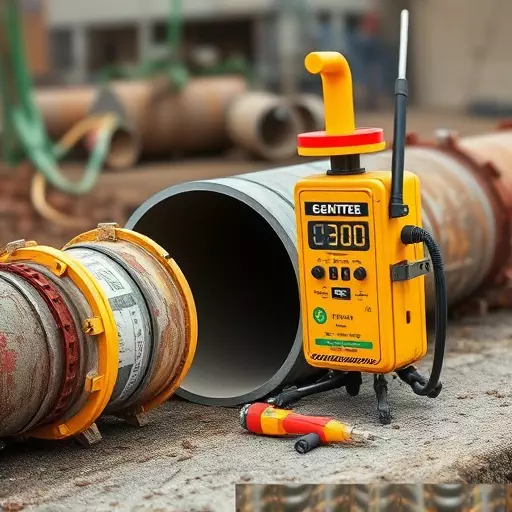Sonde and locating data are crucial for safe and efficient infrastructure maintenance and construction, especially in urban areas like Toledo. Advanced technologies like electromagnetic signals and Ground Penetration Radar (GPR) accurately map underground utilities using real-time data transmission. Trained operators use specialized equipment to emit signals, gathering critical data that's interpreted into detailed maps for precise navigation around buried assets, minimizing damage risk, and streamlining project timelines. This makes sonde techniques an indispensable tool in modern infrastructure management, particularly in cities with dense infrastructure like Toledo.
In the realm of infrastructure maintenance, precise pipe locating is paramount. This article delves into sonde and locating techniques, offering a comprehensive overview for professionals. We explore the role of sonde equipment in pipe locating and how advanced technologies enhance accuracy.
From real-time data tracking benefits and applications to understanding the challenges and best practices, this guide covers everything related to sonde and locating Toledo. Discover how these methods ensure efficient, safe, and effective infrastructure management.
- Understanding Sonde and Locating Data: A Comprehensive Overview
- The Role of Sonde Equipment in Pipe Locating
- Advanced Techniques for Accurate Sonde Locating
- Benefits and Applications of Real-Time Data Tracking
- Challenges and Considerations in Sonde Locating Operations
- Best Practices for Effective Sonde and Locating Toledo
Understanding Sonde and Locating Data: A Comprehensive Overview

Sonde and locating data play a pivotal role in various industries, particularly in infrastructure maintenance and construction projects. A sonde is an advanced piece of equipment designed to detect and map underground utilities, such as pipes, cables, and wires, with remarkable accuracy. By utilizing electromagnetic signals or other sensing technologies, sondes can identify the precise location and depth of these critical facilities. This real-time data is invaluable for professionals in the field, ensuring safe and efficient excavation or construction processes.
The process of sonde and locating involves several techniques to gather comprehensive information. Typically, a trained operator utilizes specialized sonde equipment, which may include handheld devices or vehicle-mounted systems. These tools emit signals that interact with the underground utilities, providing data on their position and other attributes. Advanced algorithms and software then interpret this data, creating detailed maps and allowing for precise navigation around buried assets. This not only minimizes the risk of damage but also streamlines project timelines, making it an indispensable tool in modern infrastructure management.
The Role of Sonde Equipment in Pipe Locating

Sonde equipment plays a pivotal role in the precise and efficient locating of pipes underground. These specialized tools are designed to navigate through the soil, detecting and mapping the exact positions of pipes, cables, and other utilities buried below. In the realm of pipe locating, sondes act as advanced sensors, transmitting real-time data that aids in identifying and marking these subterranean assets.
The process involves employing various sonde and locating techniques, where technicians use hand-held devices or vehicles equipped with sondes to sweep areas systematically. By emitting electromagnetic signals, these sondes interact with pipes, allowing for their location and depth determination. This technology is particularly crucial in urban settings where infrastructure is densely packed, ensuring safe excavation and minimizing disruptions to daily operations, thus facilitating the smooth running of cities and communities.
Advanced Techniques for Accurate Sonde Locating

In the realm of precise sonde locating, modern technology has revolutionized traditional methods, especially in urban settings like Toledo. Advanced sonde equipment for pipe locating now incorporates cutting-edge sensors and real-time data analysis, ensuring accurate identification of underground utilities. These innovative techniques go beyond basic radio detection, employing sophisticated tools such as ground penetration radar (GPR) and electromagnetic locators. GPR utilizes high-frequency radio waves to create detailed images of the subsurface, identifying objects like pipes based on their material properties. Electromagnetic locators, on the other hand, emit electromagnetic signals that induce currents in metal pipes, allowing for precise location through changes in signal strength and direction.
The synergy between these sonde and locating techniques offers unparalleled precision, significantly reducing the time and resources required for utility mapping. This is particularly beneficial in Toledo’s dense urban landscape where efficient and accurate pipe locating is crucial to avoid costly damage during construction or maintenance projects. By leveraging these advanced technologies, professionals can ensure safer, more effective navigating of underground infrastructure.
Benefits and Applications of Real-Time Data Tracking

In today’s digital era, real-time sonde locating data offers unparalleled benefits in the field of pipeline and infrastructure management. By employing advanced sonde equipment for pipe locating, professionals can now access precise and immediate information about underground utilities. This enables efficient navigation and reduces the time and cost associated with traditional locating techniques. Real-time tracking allows for quick identification of pipe locations, sizes, and materials, enhancing safety and minimizing disruptions during construction or maintenance projects.
The applications of real-time data tracking are vast. For instance, utility companies can use these techniques to prevent damage to pipes and cables during excavation, ensuring the integrity of their networks. In emergency situations, such as leaks or breaks, real-time locating provides crucial information for swift response and repair teams. Moreover, this technology aids in infrastructure planning and development by offering a comprehensive view of underground assets, facilitating informed decision-making and streamlining operations in heavily urbanized areas like Toledo.
Challenges and Considerations in Sonde Locating Operations

In Sonde and Locating Operations, several challenges require careful consideration to ensure accurate and efficient data collection. One primary hurdle is navigating complex underground landscapes, especially in densely urbanized areas or challenging terrain. Traditional sonde locating methods often struggle with interference from various factors like metallic structures, ground moisture content, and depth variations, making precise identification of pipes or cables difficult. Moreover, the rapid advancement of infrastructure demands faster and more precise locating techniques to keep up with the expanding network of utilities.
Another significant consideration is choosing the right sonde equipment for pipe locating. Different sonde types, including electromagnetic, radio frequency (RF), and ground penetration radar (GPR), offer unique advantages and limitations. Each technique must be selected based on the specific project requirements, such as soil conditions, depth of target objects, and accessibility constraints. Effective communication between operators, adherence to safety protocols, and regular maintenance of sonde equipment are also critical for successful operations, ensuring that data integrity remains unimpeded throughout the locating process.
Best Practices for Effective Sonde and Locating Toledo

When it comes to effective sonde and locating Toledo, following best practices is paramount. The right sonde equipment for pipe locating should be chosen based on the specific needs of the project, considering factors like pipe material, depth, and terrain. Utilizing advanced sonde and locating techniques, such as electromagnetic or radar technologies, can significantly enhance accuracy and efficiency. These methods allow professionals to locate pipes non-invasively, minimizing disruptions to surfaces and reducing potential damage.
Training and experience are key. Skilled technicians should be well-versed in operating various sonde equipment and understanding the nuances of different sonde and locating techniques. Regular maintenance and calibration of instruments ensure optimal performance, while adhering to safety protocols is essential for the well-being of the team and project integrity.


